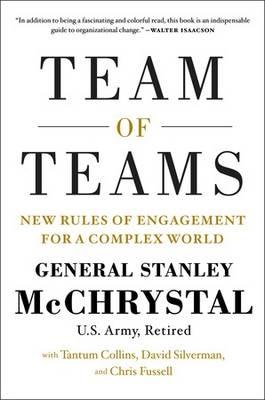Team of Teams by General Stanley McChrystal US Army, retd. with Tantum Collins, David Silverman and Chris Fussell
In this book, General McChrystal teams up with Tantum Collins, David Silverman and Chris Fussell who are partners in General McChrystal’s leadership and management system ‘Crosslead’, previously serving US Navy SEALs and a previous student, to bring together a well-researched and easy to read portrayal of modern leadership in complex environments.
In his introduction, General McChrystal states that ‘the decision to produce yet another book to help shape and lead complex organizations did not come easily’ however the lessons in leadership that he learnt and resulting transformation of the Joint Special Operations Task Force in Iraq in 2004 that he commanded were the driving force in researching and releasing the book.
To understand the fundamental principle behind the argument, the reader must first understand the difference between a complex and complicated environment as defined within the book. A complicated environment is one with many parts, ‘but those parts are joined, one to the next, in relatively simple ways’. Whereas a complex environment encompasses many different facets that are influenced by unpredictable factors and will therefore have unpredictable outcomes.
General McChrystal discusses the challenges of asymmetric warfare in a complex environment where ‘despite our pedigree, our gadgets, and our commitment, things were slipping away from us’. It is argued throughout the book that a major contributor to unsuccessful operations in complex environments is the strict chain of command that many armies subscribe to and the centralised command utilised within. The stringent hierarchical and tightly controlled manner in which these teams were commanded was noted to be drastically different to the smaller ‘team of teams’ noted by General McChrystal in 2004 that insurgents were using within the complex environment.
This ‘team of teams’ being used by insurgents allowed for decentralised command throughout the organisation and was proven to be effective when the US Army was targeting what they believed to be the head of the snake, only to find that the snake would grow another head without issue. This tactic also meant that when US forces were attempting to define the organisation through its connections and hierarchy, it proved almost impossible.
As a junior officer, several lessons within the book jumped out to me. The biggest lesson of which was the requirement to think dynamically and not accept the standard leadership techniques for every situation. This is a dangerous trap that many fall into that I personally believe begins at the training institutions where cadets receive shopping lists of leadership characteristics and techniques to memorise as opposed to thinking innovatively.
One of the fantastic examples within the book that reinforces the above point is that of the British Admiral Heratio Nelson. This example explores the traditional way in which naval battles were enacted and commanded, and the way in which Nelson commanded within the Battle of Trafalgar against the Franco-Spanish fleet which ultimately lead to his victory ‘while Nelson’s tactics echoed those of great Admirals before him, his unique innovation lay in his managerial style and the culture he had cultivated among his forces’.
Another lesson reinforced through reading this book was the requirement to plan and train for redundancy within the ranks. Where a traditional hierarchical approach to command cannot be changed, training for redundancy at every level ensures that the organisation has a plan for continuation. Utilising mission command in its purist form wherever possible also helps to build this redundancy as subordinates understand the overarching plan, have a thorough understanding of the commander’s intent and have the capabilities to enact the mission in the commander’s absence.
A thorough understanding of history is essential for any commander, however another lesson considered while reading the book was that of using historical cases to prepare for future warfare. The book describes this as ‘lessons of the last war’. A perfect example of this is the French Maginot Line which was built to defeat enemy land forces, however the wall, which took ten years to build, proved incompetent against the German Luftwaffe in WWII, which simply flew over it. This concept of stale tactics was further tied into the Iraq examples of General McChrystal.
Team of teams can be read almost like a novel due to its uncomplicated language, structure and flow. The book will draw a reader in with its intriguing historical examples of leadership in both a military and business context and the seemingly never-ending lessons to consider. The point of difference between this book and many similar military leadership books is that each chapter ends with a summary of the points covered within the chapter, thereby making the book seem more like a business world ‘how to’ guide for leadership and appealing to a much larger audience.
Due to the lessons discussed within this review and the many others that were learnt or reinforced whilst reading this book, I would recommend Team of Teams for all junior leaders as a chance to once again touch base on the importance of the basics as well as the requirement to think innovatively when challenged with a circumstance that either history, experience or doctrine does not apply.
Jess Ward is a currently serving Australian Army Officer with over a decade of experience. Jess has commanded within Combat Brigades, on Operations and as an instructor. Jess has been published in ‘Winning Westeros: How Game Of Thrones explains modern military conflict’ as well as several professional military education websites. Jess curates The Bookshelf. Follow Jess at @JessPixWard.

